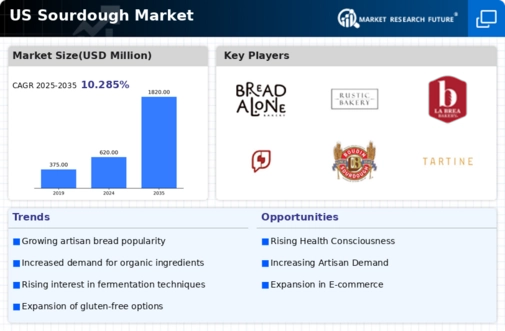The US Sourdough Market has witnessed a significant evolution in recent years, driven by rising consumer demand for artisanal and health-oriented bread options. The market is characterized by a diverse range of players, from large commercial bakeries to small artisan producers, all vying for a share of this growing segment. Increased interest in sourdough for its unique flavor profile and perceived health benefits has encouraged existing businesses to innovate their offerings, while new entrants flood the market with a variety of sourdough products.
This competitive landscape fosters both collaboration and rivalry among companies as they seek to differentiate their brands and satisfy discerning consumers. The growth of e-commerce has further transformed the distribution landscape, enabling bakeries to reach customers directly and efficiently. In this dynamic environment, understanding the competitive insights of major players serves as a key advantage for businesses looking to establish or expand their market presence in the sourdough segment.King Arthur Baking Company stands as a prominent entity within the US Sourdough Market, known for its exceptional quality and commitment to baking education.
The company's reputation is built upon its long-standing history, which equips them with deep expertise in flour production and sustainable baking practices. King Arthur Baking Company offers a wide range of sourdough-related products, including flour specifically designed for creating sourdough bread, baking mixes, and various educational resources to aid both amateur and professional bakers. Their strong brand image is further enhanced by a community-oriented approach that connects baking enthusiasts through online platforms and resource-sharing initiatives.
With a loyal customer base and significant influence among home bakers and culinary professionals, King Arthur Baking Company continues to strengthen its presence in the competitive sourdough market by consistently delivering high-quality products and maintaining strong customer engagement.Bread Alone Bakery has carved out a unique niche in the US Sourdough Market by emphasizing organic and locally sourced ingredients in their products. This commitment not only enhances the quality and flavor of their breads but also resonates with a growing consumer trend focusing on sustainability and health conscious eating.
The company's product lineup includes a variety of artisan sourdough breads, as well as ready-to-eat baked goods that cater to diverse preferences. Bread Alone Bakery boasts a solid presence in both retail and foodservice sectors, supplying their artisanal products to restaurants, cafes, and grocery chains. The company's strengths lie in its ability to innovate and adapt to market trends, such as expanding their offerings to include gluten-free options.
Bread Alone Bakery has also pursued strategic partnerships and local collaborations, reinforcing its brand image within the community and enabling them to reach new customers through unique distribution networks, thus solidifying their position in the competitive landscape of the US sourdough market.

















